曼昆经济学原理英文原版
曼昆《经济学原理》(宏观经济学分册)英文原版PPT课件

© 2007 Thomson South-Western
Table 2 Real and Nominal GDP
© 2007 Thomson South-Western
Table 2 Real and Nominal GDP
© 2007 Thomson South-Western
Table 2 Real and Nominal GDP
© 2007 Thomson South-Western
THE ECONOMY’S INCOME AND EXPENDITURE
• When judging whether the economy is doing well or poorly, it is natural to look at the total income that everyone in the economy is earning.
Y = C + I + G + NX
© 2007 Thomson South-Western
THE COMPONENTS OF GDP
• Consumption (C):
• The spending by households on goods and services, with the exception of purchases of new housing.
© 2007 Thomson South-Western
THE MEASUREMENT OF GROSS DOMESTIC PRODUCT
• The equality of income and expenditure can be illustrated with the circular-flow diagram.
曼昆经济学原理英文版
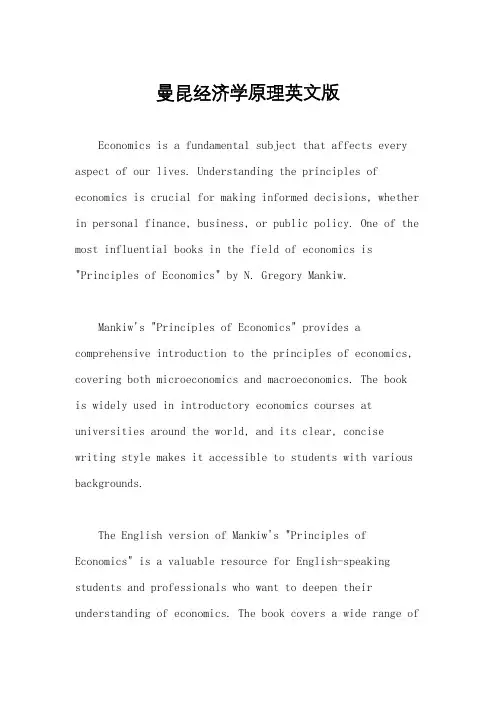
曼昆经济学原理英文版Economics is a fundamental subject that affects every aspect of our lives. Understanding the principles of economics is crucial for making informed decisions, whether in personal finance, business, or public policy. One of the most influential books in the field of economics is "Principles of Economics" by N. Gregory Mankiw.Mankiw's "Principles of Economics" provides a comprehensive introduction to the principles of economics, covering both microeconomics and macroeconomics. The book is widely used in introductory economics courses at universities around the world, and its clear, concise writing style makes it accessible to students with various backgrounds.The English version of Mankiw's "Principles of Economics" is a valuable resource for English-speaking students and professionals who want to deepen their understanding of economics. The book covers a wide range oftopics, including supply and demand, market efficiency, consumer behavior, fiscal policy, monetary policy, and international trade. By exploring these topics, readers can gain a solid foundation in economic theory and its real-world applications.One of the key strengths of Mankiw's "Principles of Economics" is its emphasis on real-world examples and applications. The book uses case studies and news articles to illustrate economic concepts and theories, helping readers connect abstract ideas to concrete situations. This approach not only makes the material more engaging and relatable but also demonstrates the relevance of economics in everyday life.In addition to its clear explanations and practical examples, Mankiw's "Principles of Economics" also provides a balanced perspective on economic issues. The book presents different schools of economic thought and encourages critical thinking about economic policy and decision-making. By considering multiple viewpoints, readers can develop a more nuanced understanding ofeconomic issues and become better equipped to analyze and evaluate economic arguments.Furthermore, the English version of Mankiw's"Principles of Economics" offers supplementary online resources, including lecture notes, practice questions, and interactive quizzes. These resources enhance the learning experience and provide additional support for readers who want to reinforce their understanding of the material.Overall, Mankiw's "Principles of Economics" is an essential read for anyone interested in economics. Whether you are a student, a professional, or simply a curious reader, this book offers valuable insights into the principles that shape economic behavior and decision-making. With its clear writing, real-world examples, and balanced perspective, the English version of Mankiw's "Principles of Economics" is a valuable resource for anyone seeking to develop a deeper understanding of the economic forces that drive our world.。
曼昆经济学原理(双语)1.1
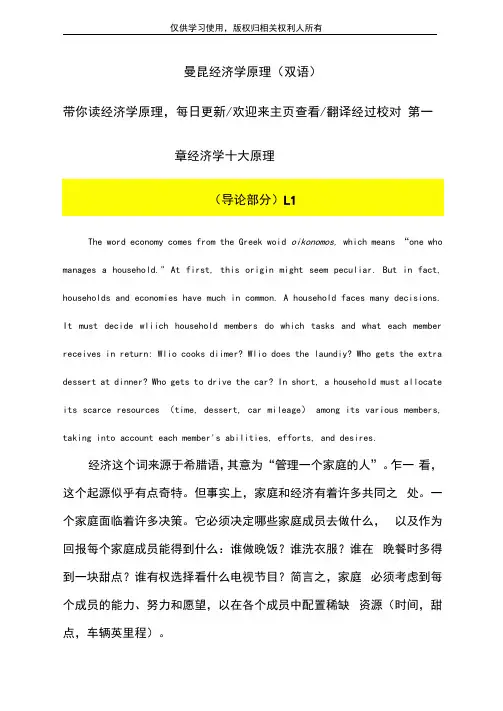
曼昆经济学原理(双语)带你读经济学原理,每日更新/欢迎来主页查看/翻译经过校对第一章经济学十大原理The word economy comes from the Greek woid oikonomos,which means “one who manages a household." At first, this origin might seem peculiar. But in fact, households and economies have much in common. A household faces many decisions. It must decide wliich household members do which tasks and what each member receives in return: Wlio cooks diimer? Wlio does the laundiy? Who gets the extra dessert at dinner? Who gets to drive the car? In short, a household must allocate its scarce resources (time, dessert, car mileage) among its various members, taking into account each member's abilities, efforts, and desires.经济这个词来源于希腊语,其意为“管理一个家庭的人”。
乍一看,这个起源似乎有点奇特。
但事实上,家庭和经济有着许多共同之处。
一个家庭面临着许多决策。
它必须决定哪些家庭成员去做什么,以及作为回报每个家庭成员能得到什么:谁做晚饭?谁洗衣服?谁在晚餐时多得到一块甜点?谁有权选择看什么电视节目?简言之,家庭必须考虑到每个成员的能力、努力和愿望,以在各个成员中配置稀缺资源(时间,甜点,车辆英里程)。
曼昆《经济学原理》(宏观经济学分册)英文原版PPT课件
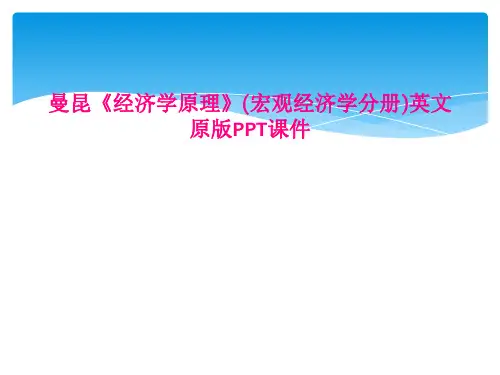
THE COMPONENTS OF GDP • GDP includes all items produced in the economy and sold legally n markets. • What Is Not Counted in GDP?
– Every transaction has a buyer and a seller. – Every dollar of spending by some buyer is a dollar of income for some seller.
© 2007 Thomson South-Western
Y = C + I + G + NX
© 2007 Thomson South-Western
THE COMPONENTS OF GDP • Consumption (C):
• The spending by households on goods and services, with the exception of purchases of new housing. • Investment (I):
© 2007 Thomson South-Western
Table 2 Real and Nominal GDP
© 2007 Thomson South-Western
Table 2 Real and Nominal GDP
© 2007 Thomson South-Western
Table 2 Real and Nominal GDP
• “. . . Final . . .” – It records only the value of final goods, not intermediate goods (the value is counted only once).
曼昆微观经济学经济学十大原理 英文版
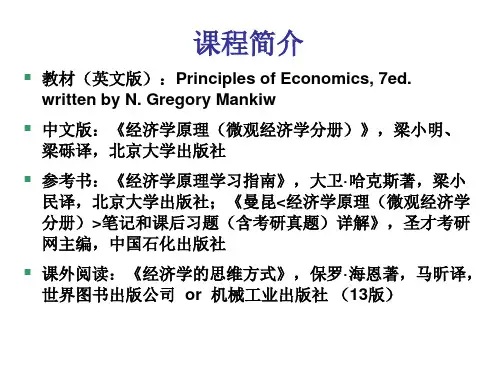
1
CHAPTER
1
Ten Principles of Economics (经济学十大原理)
Economics
PRINCIPLES OF
N. Gregory Mankiw
© 2015 CUFE
In this chapter, look for the answers to these questions:
边际是高等数学微分的概念;理性人决策:边际收益>边际成
本(Do);边际收益<边际成本(Undo)
13
HOW PEOPLE MAKE DECISIONS
Principle #3: 理性人考虑边际量
Rational People Think at the Margin Exampconsiders whether to go to
HOW PEOPLE MAKE DECISIONS
Principle #2: 某种东西的成本是为了得到它而放弃的东西
The Cost of Something Is What You Give Up to Get It
Making decisions requires comparing the costs and
7
Society faces an important tradeoff:
HOW PEOPLE MAKE DECISIONS Principle #1: 人们面临权衡取舍
效率 (efficiency) vs. 平等 (equality)
Efficiency: 社会能从稀缺资源获得最大利益的特性 . when
college for an additional year, he compares the fees & foregone wages to the extra income he could earn with the extra year of education.
曼昆经济学原理英文书
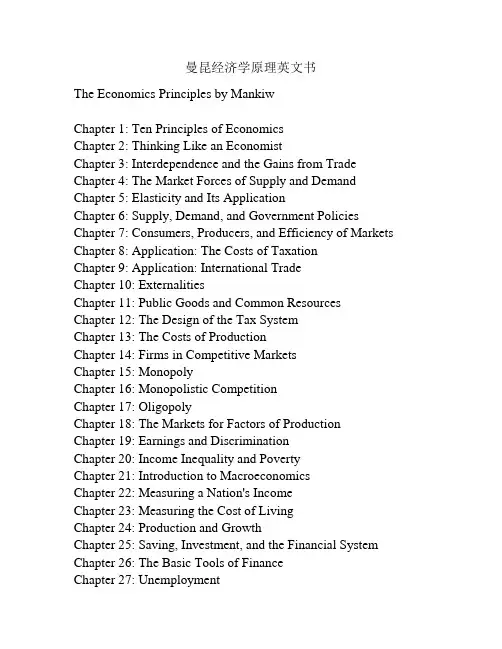
曼昆经济学原理英文书The Economics Principles by MankiwChapter 1: Ten Principles of EconomicsChapter 2: Thinking Like an EconomistChapter 3: Interdependence and the Gains from Trade Chapter 4: The Market Forces of Supply and Demand Chapter 5: Elasticity and Its ApplicationChapter 6: Supply, Demand, and Government Policies Chapter 7: Consumers, Producers, and Efficiency of Markets Chapter 8: Application: The Costs of TaxationChapter 9: Application: International TradeChapter 10: ExternalitiesChapter 11: Public Goods and Common Resources Chapter 12: The Design of the Tax SystemChapter 13: The Costs of ProductionChapter 14: Firms in Competitive MarketsChapter 15: MonopolyChapter 16: Monopolistic CompetitionChapter 17: OligopolyChapter 18: The Markets for Factors of Production Chapter 19: Earnings and DiscriminationChapter 20: Income Inequality and PovertyChapter 21: Introduction to MacroeconomicsChapter 22: Measuring a Nation's IncomeChapter 23: Measuring the Cost of LivingChapter 24: Production and GrowthChapter 25: Saving, Investment, and the Financial System Chapter 26: The Basic Tools of FinanceChapter 27: UnemploymentChapter 28: The Monetary SystemChapter 29: Money Growth and InflationChapter 30: Open-Economy Macroeconomics: Basic Concepts Chapter 31: A Macroeconomic Theory of the Open Economy Chapter 32: Aggregate Demand and Aggregate SupplyChapter 33: The Influence of Monetary and Fiscal Policy on Aggregate DemandChapter 34: The Short-Run Trade-Off between Inflation and UnemploymentChapter 35: The Theory of Consumer ChoiceChapter 36: Frontiers of MicroeconomicsChapter 37: Monopoly and Antitrust PolicyChapter 38: Oligopoly and Game TheoryChapter 39: Externalities, Public Goods, and Environmental Policy Chapter 40: Uncertainty and InformationChapter 41: Aggregate Demand and Aggregate Supply Analysis Chapter 42: Understanding Business CyclesChapter 43: Fiscal PolicyChapter 44: Money, Banking, and Central BankingChapter 45: Monetary PolicyChapter 46: Inflation, Disinflation, and DeflationChapter 47: Exchange Rates and the International Financial SystemChapter 48: The Short - Run Trade - Off between Inflation and Unemployment RevisitedChapter 49: Macroeconomic Policy: Challenges in the Twenty - First CenturyEpilogue: 14 Big IdeasNote: The chapter titles have been abbreviated for simplicity and brevity purposes.。
曼昆经济学原理(双语)1.11
曼昆经济学原理(双语)带你读《经济学原理》,每日更新,欢迎来主页查看。
翻译部分经本人校对修改,本文仅供学习交流使用,版权归相关权利人所有!第一章经济学十大原理原理八How the Economy as a Whole Works整体经济如何运行We started by discussing how individuals make decisions and then looked at how people interact with one another. All these decisions and interactions together make up “the economy.” The last three principles concern the workings of the economy as a whole.我们从讨论个人如何作出决策开始,然后考察人们如何相互作用。
所有这些决策和相互作用共同组成了“经济”。
后三个原理涉及到整体经济的运行。
Principle 8: A Country’s Standard of Living Depends on Its Ability to Produce Goods and Services原理八:一国的生活水平取决于它生产物品与劳务的能力The differences in living standards around the world are staggering. In 2014, the average American had an income of about $55,000. In thesame year, the average Mexican earned about $17,000, the average Chinese about $13,000, and the average Nigerian only $6,000. Not surprisingly, this large variation in average income is reflected in various measures of quality of life. Citizens of high-income countries have more TV sets, more cars, better nutrition, better healthcare, and a longer life expectancy than citizens of low-income countries.世界各国生活水平的差别是惊人的。
曼昆经济学原理(双语)1.6
曼昆经济学原理(双语)带你读《经济学原理》,每日更新,欢迎来主页查看。
翻译部分经本人校对修改,本文仅供学习交流使用,版权归相关权利人所有!第一章经济学十大原理原理五How People Interact人们如何相互作用The first four principles discussed how individuals make decisions. As we go about our lives, many of our decisions affect not only ourselves but other people as well. The next three principles concern how people interact with one another.前四个原理讨论了人们如何作出决策。
在我们人生的旅途中,我们的许多决策不仅影响我们自己,而且还影响其他人。
以下三个原理是关于人们之间如何相互作用。
Principle 5: Trade Can Make Everyone Better Off原理五:贸易能使每个人状况更好You may have heard on the news that the Chinese are our competitors in the world economy. In some ways, this is true becauseAmerican and Chinese firms produce many of the same goods. Companies in the United States and China compete for the same customers in the markets for clothing, toys, solar panels, automobile tires, and many other items.你可能在新闻中听说,中国人是我们在世界经济中的竞争对手。
曼昆《经济学原理》英文版完整讲义丛elasticity精品文档45页
Copyright © 2004 South-Western/Thomson Learning
(2.(21001028.)00)1010001200% %2 2.00
Copyright © 2004 South-Western/Thomson Learning
The Midpoint Method: A Better Way to Calculate Percentage Changes and Elasticities • The midpoint formula is preferable when
increases from $2.00 to $2.20 and the amount
you buy falls from 10 to 8 cones, then your
elasticity of demand, using the midpoint
Elasticity . . .
• … allows us to analyze supply and demand with greater precision.
• … is a measure of how much buyers and sellers respond to changes in market conditions
Copyright © 2004 South-Western/Thomson Learning
The Price Elasticity of Demand and Its Determinants • Demand tends to be more elastic :
曼昆《经济学原理》(宏观经济学分册)英文原版PPT课件 25
How Productivity Is Determined • Physical capital per worker is the stock of equipment and structures that are used to produce goods and services. • Physical capital includes:
© 2007 Thomson South-Western
How Productivity Is Determined • The inputs used to produce goods and services are called the factors of production. • The factors of production include:
© 2007 Thomson South-Western
FYI: The Production Function • The preceding equation says that productivity (Y/L) depends on:
• • • • physical capital per worker (K/L), human capital per worker (H/L), and natural resources per worker (N/L), as well as the state of technology (A).
• Y/ L = A F(1, K/L, H/L, N/L) • Where:
• • • • Y/L = output per worker K/L = physical capital per worker H/L = human capital per worker N/L = natural resources per worker
- 1、下载文档前请自行甄别文档内容的完整性,平台不提供额外的编辑、内容补充、找答案等附加服务。
- 2、"仅部分预览"的文档,不可在线预览部分如存在完整性等问题,可反馈申请退款(可完整预览的文档不适用该条件!)。
- 3、如文档侵犯您的权益,请联系客服反馈,我们会尽快为您处理(人工客服工作时间:9:00-18:30)。
FIRMS ?Produce and sell goods and services ?Hire and use factors of production
HOUSEHOLDS ?Buy and consume goods and services ?Own and sell factors of production
? 2007 Thomson South-Western
Measuring a Nation 's Income
Microeconomics is the study of how individual households and firms make decisions and how they interact with one another in markets.
? “. . . Produced . . .”
– It includes goods and services currently produced, not transactions involving goods produced in the past.
?Why do production and employment expand in some years and contract in others?
THE ECONOMY 'S INCOME AND EXPENDITURE
? When judging whether the economy is doing well or poorly, it is natural to look at the total income that everyone in the economy is earning.
? “. . . Final . . .”
– It records only the value of final goods, not intermediate goods (the value is counted only once).
? “. . . Goods and Services . . .”
of income for some seller.
Figure 1 The Circular-Flow Diagram
Revenue
Goods and services sold
MARKETS FOR
GOODS AND SERVICES ?Firms sell ?Households buy
Spending
DOMESTIC PRODUCT
? “GDP is the Market Value . . .”
– Output is valued at market prices.
? “. . . Of All. . .”
– Includes all items produced in the economy and legally sold in markets
Macroeconomics is the study of the economy as a whole. Its goal is to explain the economic changes that affect many households, firms, and markets at once.
THE MEASUREMENT OF GROSS DOMESTIC PRODUCT
? The equality of income and expenditure can be illustrated with the circular-flow diagram.
THE MEASUREMENT OF GROSS
– It includes both tangible goods (food, clothing, cars) and intangible services (haircuts, housecleaning, doctor visits).
THE MEASUREMENT OF GROSS DOMESTIC PRODUCT
Factors of production
Wages, rent, and profit
Hale Waihona Puke MARKETS FORFACTORS OF PRODUCTION
?Households sell ?Firms buy
Labor, land, and capital
Income
= Flow of inputs and outputs
= Flow of dollars
THE MEASUREMENT OF GROSS DOMESTIC PRODUCT
? Gross domestic product (GDP) is a measure of the income and expenditures of an economy.
? GDP is the total market value of all final goods and services produced within a country in a given period of time.
THE ECONOMY 'S INCOME AND EXPENDITURE
? For an economy as a whole, income must equal expenditure because:
– Every transaction has a buyer and a seller. – Every dollar of spending by some buyer is a dollar
Measuring a Nation 's Income
Macroeconomics answers questions like the following:
?Why is average income high in some countries and low in others?
?Why do prices rise rapidly in some time periods while they are more stable in others?
